THIS Fall 2017
November 11, 2017
On November 10 and 11, after many years of talking about it, we finally had a first regional Texas Heavy-Ion & Spin physics symposium at our very own Rice campus. Within less than 2.5hr drive we have five institutes that are involved in heavy-ion and spin physics related research. Our goal is to bring graduate students and postdocs together and present their work to their peers in a friendly setting. Thirty-nine faculty, postdocs, and students showed up for this 2-day event and listened to sixteen very well prepared presentations. This was a great success and we hope next year to see a repeat of this. For more information go to THIS2017.
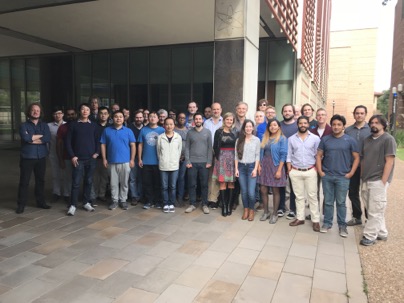
On the picture you can see all participants nicely lined up in front of the Brockman Hall for Physics. If you carefully zoom in on the column in the back you will see a bronze(!) event display of a Au+Au collision in the STAR detector.

On the picture you can see all participants nicely lined up in front of the Brockman Hall for Physics. If you carefully zoom in on the column in the back you will see a bronze(!) event display of a Au+Au collision in the STAR detector.
Santa Monica "SMASH" Elementary School (outreach part 2!)
October 25, 2017
Ask a nuclear physicist!
What a great idea! Using FaceTime I talked for more than half an hour (was it a full hour?) to an elementary school 3rd/4th grade class in Santa Monica, CA. The children had all prepared themselves and provided the fantastic teacher (Alejandra Santini) with a big stack of questions. And, boy, those were some good questions!! Thankfully I had already done some calculations so that I could help the students answer the questions of the energy of TNT (Minecraft!) vs. that of a QGP ... This was also a great time to show of my Particle Zoo pluche puppets.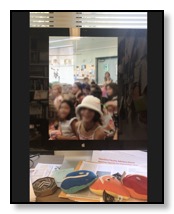 And, at the end the whole class sang their Periodic Table Song to me. I could not stop laughing (and they could not stop singing!). A special shout-out to Alejandra Santini, her excellent class, Guido Faas (who was instrumental in setting this up), and of course my best friend ... Archer!
And, at the end the whole class sang their Periodic Table Song to me. I could not stop laughing (and they could not stop singing!). A special shout-out to Alejandra Santini, her excellent class, Guido Faas (who was instrumental in setting this up), and of course my best friend ... Archer!
What a great idea! Using FaceTime I talked for more than half an hour (was it a full hour?) to an elementary school 3rd/4th grade class in Santa Monica, CA. The children had all prepared themselves and provided the fantastic teacher (Alejandra Santini) with a big stack of questions. And, boy, those were some good questions!! Thankfully I had already done some calculations so that I could help the students answer the questions of the energy of TNT (Minecraft!) vs. that of a QGP ... This was also a great time to show of my Particle Zoo pluche puppets.

Klein High School - (outreach part 1)
October 24, 2017
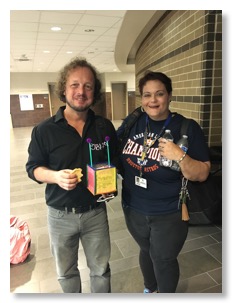
Strangeness in Quark Matter 2017 (Utrecht, The Netherlands)
July 17, 2017
On July 10, Utrecht University in the Netherlands hosted the 17th edition of the International Conference on Strangeness in Quark Matter -a.k.a. by its acronym SQM 2017. Over a 6-day long timespan, more than 200 physicists met and discussed strange quarks and hadrons in hot and cold nuclear matter. This year, the organizers decid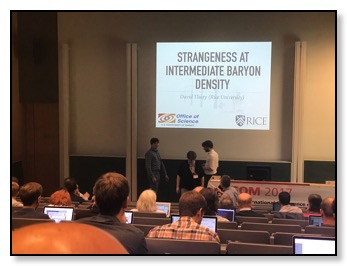 ed to broaden the spectrum by including contributions on the heavier quarks, charm and bottom. David Tlusty presented in his invited plenary presentation an overview of recent strangeness results from two collaborations that actively probe the intermediate baryon chemical potential range of the QCD phase diagram: NA61 at CERN, and STAR at RHIC. A direct link to his slides can be found here. Frank chaired one of the parallel sessions that took place on Friday.
ed to broaden the spectrum by including contributions on the heavier quarks, charm and bottom. David Tlusty presented in his invited plenary presentation an overview of recent strangeness results from two collaborations that actively probe the intermediate baryon chemical potential range of the QCD phase diagram: NA61 at CERN, and STAR at RHIC. A direct link to his slides can be found here. Frank chaired one of the parallel sessions that took place on Friday.

PhD Thesis defense Joey Butterworth
April 11, 2017
Congratulations to Joey Butterworth for his successfull defense on April 11 of his PhD thesis on "Electron-positron pair production in Au+Au collisions at √sNN= 27 GeV as part of the Beam Energy Scan Program at STAR"
From the official announcement:
This thesis reports the e+e- pair production in the top 80% most central Au on Au collisions at √sNN = 27 GeV from the STAR experiment. The production exhibits an excess yield, in the low invariant mass region (M(e+e-) ≤1.2 GeV/c2), when compared to a hadronic cocktail without ρ-meson contributions. This excess yield is shown to be successfully described by model calculations that include a broadening of the ρ-meson spectral function in a hot, dense medium, and similar agreement to the excess yield, after applying an acceptance-correction, is also exhibited. These results are a part of a systematic study of the e+e- pair production in Relativistic Heavy Ion Collider Beam Energy Scan Program and are presented with data from Au on Au collisions at √sNN = 19.6, 39, 62.4, and 200 GeV. Each collision energy e+e- pair measurement has an excess with respect to a hadronic model without ρ-meson contributions, and each excess yield is described by model calculations that include a broadening of the ρ-meson spectral function in a hot, dense medium. This suggests that the ρ meson is modified by the hot, dense medium. The acceptance-corrected excess yields are also reported as a function √sNN, charged particle multiplicity, and predicted lifetimes. Given uncertainties, no statistically significant excess yield dependence on √sNN, charged particle multiplicity, and predicted lifetimes are observed for Au on Au collisions with a 0-80% centrality.
From the official announcement:
This thesis reports the e+e- pair production in the top 80% most central Au on Au collisions at √sNN = 27 GeV from the STAR experiment. The production exhibits an excess yield, in the low invariant mass region (M(e+e-) ≤1.2 GeV/c2), when compared to a hadronic cocktail without ρ-meson contributions. This excess yield is shown to be successfully described by model calculations that include a broadening of the ρ-meson spectral function in a hot, dense medium, and similar agreement to the excess yield, after applying an acceptance-correction, is also exhibited. These results are a part of a systematic study of the e+e- pair production in Relativistic Heavy Ion Collider Beam Energy Scan Program and are presented with data from Au on Au collisions at √sNN = 19.6, 39, 62.4, and 200 GeV. Each collision energy e+e- pair measurement has an excess with respect to a hadronic model without ρ-meson contributions, and each excess yield is described by model calculations that include a broadening of the ρ-meson spectral function in a hot, dense medium. This suggests that the ρ meson is modified by the hot, dense medium. The acceptance-corrected excess yields are also reported as a function √sNN, charged particle multiplicity, and predicted lifetimes. Given uncertainties, no statistically significant excess yield dependence on √sNN, charged particle multiplicity, and predicted lifetimes are observed for Au on Au collisions with a 0-80% centrality.
Joint CBM/STAR Meeting
March 23, 2017
[based on STAR Newsletter contribution by Geary Eppley]
The STAR Collaboration and the Compressed Baryonic Matter Collaboration held a joint workshop in the historic art deco clock tower auditorium at the Technische Universitat Darmstadt on Saturday March 18. CBM
and STAR are collaborating on an endcap time-of-flight detector for the Beam Energy Scan phase II at RHIC, scheduled for 2019-2020. The eTOF upgrade will greatly enhance the physics reach for BES-II and provide a full-scale integration and systems test for almost 10% of the planned CBM TOF system. The joint CBM-STAR project is part of the FAIR Phase 0 program to test detector components prior to the completion of CBM and the Facility for Antiproton and Ion Research accelerator at GSI Darmstadt, scheduled for 2025.
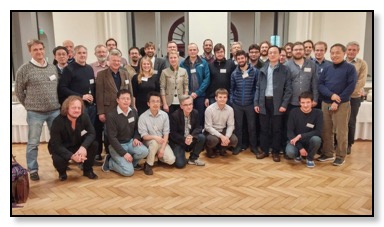
This first CBM-STAR joint workshop attracted 48 physicists from the US, China, and Europe. The sixteen presentations during the one-day Saturday session covered topics of interest for BES-II, CBM, and HADES from both an experimental and theory point of view. Geary Eppley convened the opening session which mostly focussed on some of the relevant hardware advances towards BES-II. Daniel Brandenburg and Florian Seck (who visited Rice in the Fall of 2016) presented the plans for dilepton measurements and recent theory developments, respectively. Frank Geurts discussed improvements and opportunities in bulk spectra.
The workshop was delicious as well. The organizers provided a sumptuous Italian buffet for lunch and a traditional Hessian buffet Saturday evening. There was also a productive discussion session Sunday morning following the workshop. The CBM Collaboration meeting began Monday. There was a construction readiness review of MRPC production for the eTOF modules. Construction of the first batch, about 10% of the 108 MRPCs needed for the full eTOF, is scheduled to begin this May. A complete sector of eTOF, covering one TPC sector, will be installed at STAR for Run 18. The second CBM-STAR joint workshop is scheduled in conjunction with the next CBM collaboration meeting in Wuhan, September 25-29.
The STAR Collaboration and the Compressed Baryonic Matter Collaboration held a joint workshop in the historic art deco clock tower auditorium at the Technische Universitat Darmstadt on Saturday March 18. CBM
and STAR are collaborating on an endcap time-of-flight detector for the Beam Energy Scan phase II at RHIC, scheduled for 2019-2020. The eTOF upgrade will greatly enhance the physics reach for BES-II and provide a full-scale integration and systems test for almost 10% of the planned CBM TOF system. The joint CBM-STAR project is part of the FAIR Phase 0 program to test detector components prior to the completion of CBM and the Facility for Antiproton and Ion Research accelerator at GSI Darmstadt, scheduled for 2025.

This first CBM-STAR joint workshop attracted 48 physicists from the US, China, and Europe. The sixteen presentations during the one-day Saturday session covered topics of interest for BES-II, CBM, and HADES from both an experimental and theory point of view. Geary Eppley convened the opening session which mostly focussed on some of the relevant hardware advances towards BES-II. Daniel Brandenburg and Florian Seck (who visited Rice in the Fall of 2016) presented the plans for dilepton measurements and recent theory developments, respectively. Frank Geurts discussed improvements and opportunities in bulk spectra.
The workshop was delicious as well. The organizers provided a sumptuous Italian buffet for lunch and a traditional Hessian buffet Saturday evening. There was also a productive discussion session Sunday morning following the workshop. The CBM Collaboration meeting began Monday. There was a construction readiness review of MRPC production for the eTOF modules. Construction of the first batch, about 10% of the 108 MRPCs needed for the full eTOF, is scheduled to begin this May. A complete sector of eTOF, covering one TPC sector, will be installed at STAR for Run 18. The second CBM-STAR joint workshop is scheduled in conjunction with the next CBM collaboration meeting in Wuhan, September 25-29.
Quark Matter 2017 (Chicago)
February 11, 2017
In an icy cold yet not snow-covered Chicago, a group of seven Rice students, postdocs, and faculty presented exciting results from the STAR and CMS heavy-ion programs at the XXVI international conference on ultrarelativistic heavy-ion collisions, also know as Quark Matter 2017. This conference is considered one of the, if not the, most important conferences in the field. The conference series is typically held on a 18-month schedule. This year more than 700 participants joined from all over the world to listen to the many plenary and parallel sessions, as well as discuss the approximately 400 posters.
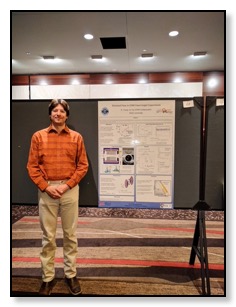
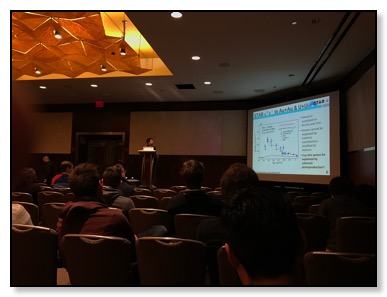
Daniel Brandenburg gave an oral presentation on some recent, exciting results in low-transverse momentum dielectron spectra which appear to show a consistent and significant excess as a function of the (virtual) dielectron mass. He also showed some first preliminary results of a dilepton analysis that involves muons instead of electrons and is based on the output of the MTD detector.
David Tlusty presented a poster on his recent results the measurement of directed flow from proton, Lambda and K0s in fixed-target collisions measured by the STAR detector (which is designed for collider mode, so this is a rather unconventional way of using the detector!).
Frank Geurts presented a posted on the Endcap Time-of-Flight detector, one of the future detector upgrades that STAR together with the CBM Collaboration (in the context of FAIR Phase 0) envision for the upcoming second phase of the RHIC Beam Energy Scan.
The direct links to the presentations are listed below.


Daniel Brandenburg gave an oral presentation on some recent, exciting results in low-transverse momentum dielectron spectra which appear to show a consistent and significant excess as a function of the (virtual) dielectron mass. He also showed some first preliminary results of a dilepton analysis that involves muons instead of electrons and is based on the output of the MTD detector.
David Tlusty presented a poster on his recent results the measurement of directed flow from proton, Lambda and K0s in fixed-target collisions measured by the STAR detector (which is designed for collider mode, so this is a rather unconventional way of using the detector!).
Frank Geurts presented a posted on the Endcap Time-of-Flight detector, one of the future detector upgrades that STAR together with the CBM Collaboration (in the context of FAIR Phase 0) envision for the upcoming second phase of the RHIC Beam Energy Scan.
The direct links to the presentations are listed below.
- Daniel Brandenburg on Dilepton production in p+p, Au+Au collisions at sqrt(sNN)=200GeV and U+U collisions at sqrt(sNN)=193GeV
- David Tlusty on Strange Hadrons Spectra and Directed Flow in STAR Fixed target Experiment
- Frank Geurts on The STAR eTOF Upgrade
Winter Workshop on Nuclear Dynamics (Snowbird, Utah)
January 20, 2017
David Tlusty and Frank Geurts both traveled earlier this month to Snowbird (Utah) to attend the 33rd Winter Workshop on Nuclear Dynamics.This long-standing workshop series takes up a unique position amongst high energy nuclear and particle physics workshops in that it sees an attendance of of theorists and experimental scientists from US and European institutes as well as Asian and African institutes!
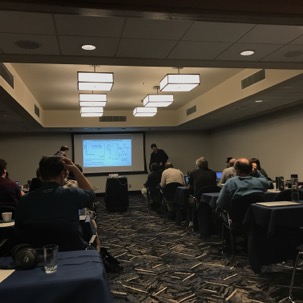 The combination including representations from almost all major experimental heavy-ion collaborations provide for an ideal environment to discuss current developments in the field. The format of morning and evening presentations further allow for ample time for in-person discussions in the afternoon, either in the ski lift (Frank does not ski) or when strolling along the beach when the workshop is held at warmer locations.
The combination including representations from almost all major experimental heavy-ion collaborations provide for an ideal environment to discuss current developments in the field. The format of morning and evening presentations further allow for ample time for in-person discussions in the afternoon, either in the ski lift (Frank does not ski) or when strolling along the beach when the workshop is held at warmer locations.
David (see picture) presented a set of first results on directed flow measurements from the fixed-target data that was taken in a, short, dedicated run in 2015. Frank talked about exciting new opportunities that the STAR collaboration recently proposed in a joint detector upgrade effort with the CBM collaboration in Germany in what is generally referred to as FAIR Phase 0.
The Winter Workshop on Nuclear Dynamics is organized by Rene Bellwied (UH), Anthony Timmins (UH), and Frank Geurts (Rice).

David (see picture) presented a set of first results on directed flow measurements from the fixed-target data that was taken in a, short, dedicated run in 2015. Frank talked about exciting new opportunities that the STAR collaboration recently proposed in a joint detector upgrade effort with the CBM collaboration in Germany in what is generally referred to as FAIR Phase 0.
The Winter Workshop on Nuclear Dynamics is organized by Rene Bellwied (UH), Anthony Timmins (UH), and Frank Geurts (Rice).
Daniel Brandenburg Junior Representative STAR Council
January 09, 2017
The results from last December's elections are in and Daniel Brandenburg has been elected Junior Representative for the STAR Council. Congratulations! He follows what by now is a tradition of very active junior involvement from the Rice group. STAR Council's Junior representatives (2 students and 1 postdoc) provide for an important voice in the Council. They also organize the Junior days that typically take place the day before a STAR Collaboration Meeting.
